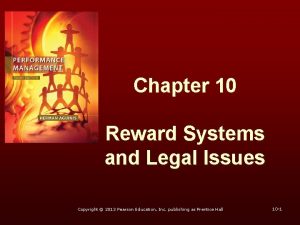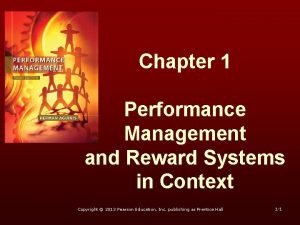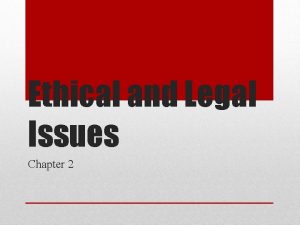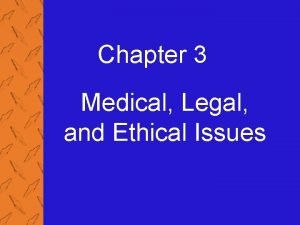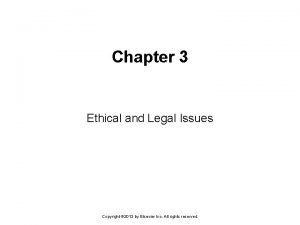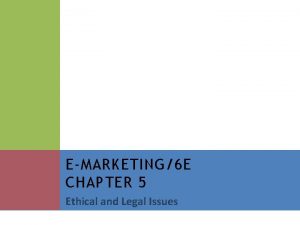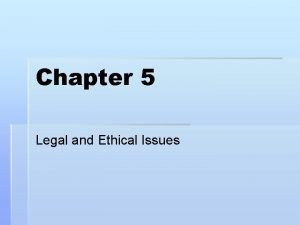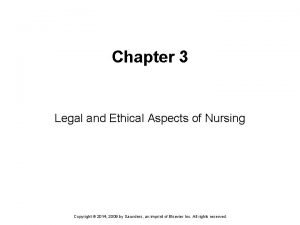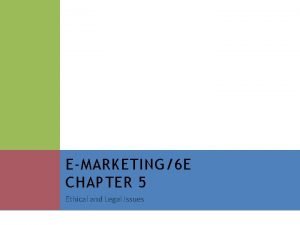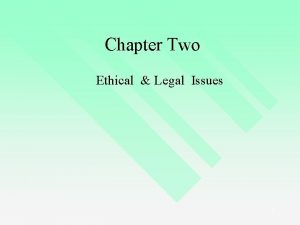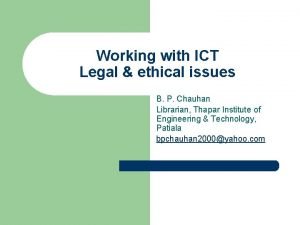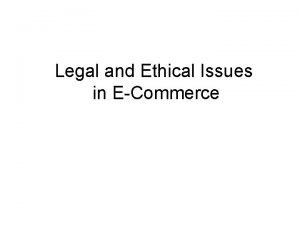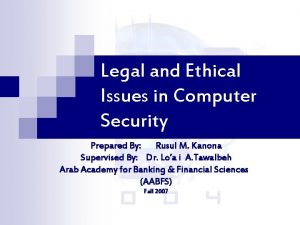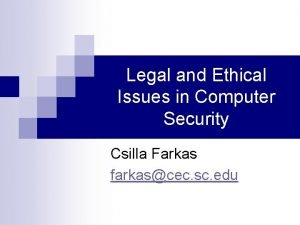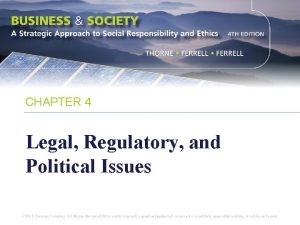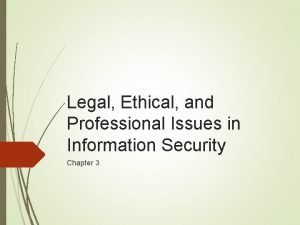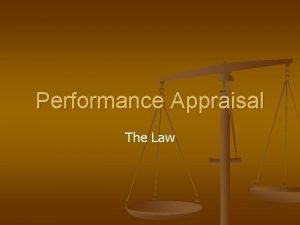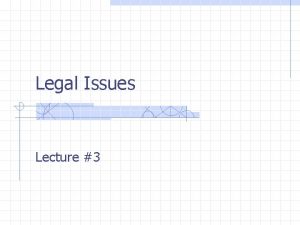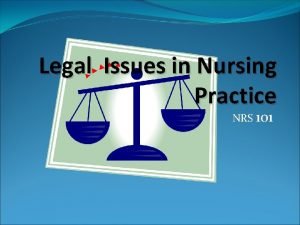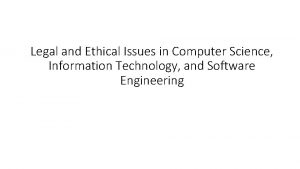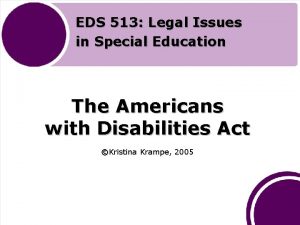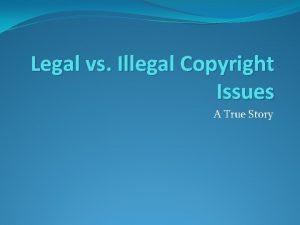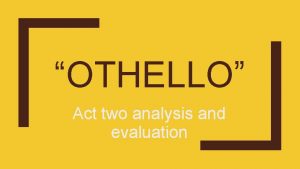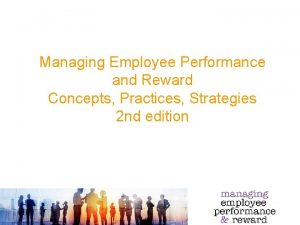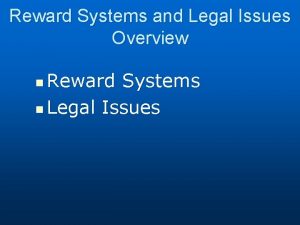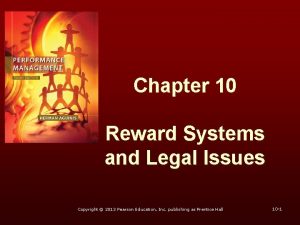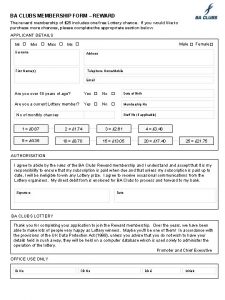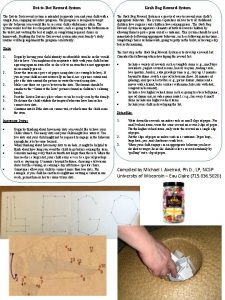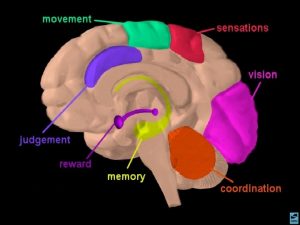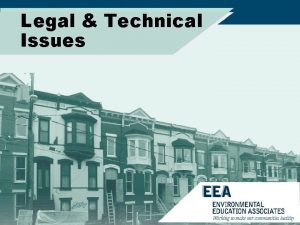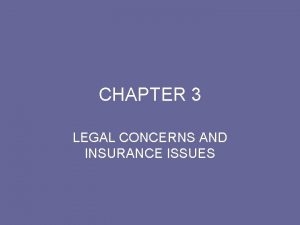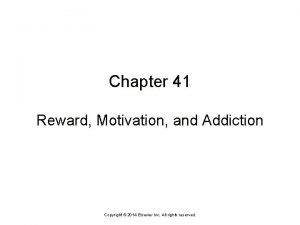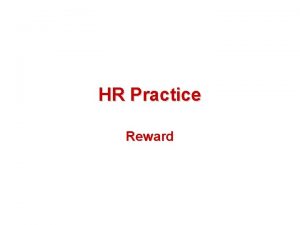Chapter 10 Reward Systems and Legal Issues Copyright













































- Slides: 45

Chapter 10 Reward Systems and Legal Issues Copyright © 2013 Pearson Education, Inc. publishing as Prentice Hall 10 -1

Traditional Pay Plans In traditional pay plans the type of position and seniority – not performance - are determinants of salary and salary increases. Typically, there is a pay range that determines minimum, midpoint, and maximum rates for each job (e. g. , Assistant Professor pay range: $60, 000$90, 000). Copyright © 2013 Pearson Education, Inc. publishing as Prentice Hall 10 -2

Contingent Pay (CP) Plans Contingent Pay (CP) plans, also called Pay for Performance, mean that employees are rewarded based on how well they perform on the job. Thus, employees receive pay increases based wholly or in part on their job performance. These increases can either be added to an employee’s base salary or be a one-time bonus. When increases are not added to an employee’s base salary they are called variable pay. Copyright © 2013 Pearson Education, Inc. publishing as Prentice Hall 10 -3

Reasons for Introducing CP Plans n n n Performance management systems are more effective when results are directly tied to the reward system. CP Plans force organizations to clearly define effective performance and determine what factors are likely to lead to effective performance. When a CP Plan is implemented, organizations must make clear what specific behaviors or results will be rewarded and how employees can achieve these behaviors or results. Thus, supervisors and employees are better able to understand what really matters. Copyright © 2013 Pearson Education, Inc. publishing as Prentice Hall 10 -4

Reasons for Introducing CP Plans CP plans enhance employee motivation to accomplish goals that match organizational needs. n CP plans help to recruit and retain top performers. n CP plans project a good corporate image. n Copyright © 2013 Pearson Education, Inc. publishing as Prentice Hall 10 -5

CP Plans and Employee Motivation CP Plans can help to improve the motivation of employees when each of the following conditions are present: • Employees see a clear link between their efforts and resulting performance. (Expectancy) • Employees see a clear link between their performance level and rewards received. (Instrumentality) • Employees value the rewards available. (Valence) Motivation = Expectancy x Instrumentality x Valence Copyright © 2013 Pearson Education, Inc. publishing as Prentice Hall 10 -6

Possible Problems Associated with CP Plans may not succeed because: n a poor PM system is in place. n the PM system rewards behaviors and results that do not help the organization succeed. n rewards are not considered significant n managers are not accountable for how they handle the PM system and, therefore, are likely to inflate ratings so employees receive what managers think are appropriate rewards. n sole emphasis on rewards can lead to ignoring the fact that employee motivation can be achieved not only by providing rewards but by creating a more challenging, interesting work environment (intrinsic rewards) n Disproportionately large rewards for executives Copyright © 2013 Pearson Education, Inc. publishing as Prentice Hall 10 -7

Issues to Consider When Selecting a CP Plan § § Culture of the organization. Strategic direction of the organization. Copyright © 2013 Pearson Education, Inc. publishing as Prentice Hall 10 -8

Culture of the Organization and Appropriate Type of CP Plan n Traditional cultures - characterized by top -down decision making, vertical communication, and clearly defined jobs. An effective choice for these cultures would be a plan that rewards specific and observable measures of performance, where that performance is clearly defined and directly linked to pay (e. g. , Piece rate, Sales commissions, Group incentives). Copyright © 2013 Pearson Education, Inc. publishing as Prentice Hall 10 -9

Culture of the Organization and Appropriate Type of CP Plan (continued) Involvement cultures – characterized by shared decision making, lateral communication, and loosely defined roles. An effective choice for these cultures would be: • Profit sharing – Employees are paid based on the performance of a group (e. g. , a team or unit) and whether the group has exceeded a specific financial goal. • Skill-based pay – Employees are paid based on whether they acquire new knowledge or skills that benefit the organization. n Copyright © 2013 Pearson Education, Inc. publishing as Prentice Hall 10 -10

Strategic Direction of the Organization In addition to organizational culture, an organization’s strategic objectives are an important consideration in selecting a CP plan. For example, n If employee development is a strategic objective, rewards should emphasize new skills acquired (Skill-based pay). n If customer service is a strategic objective, rewards should emphasize competencies related to customer service (Competency-based pay). Copyright © 2013 Pearson Education, Inc. publishing as Prentice Hall 10 -11

Putting Pay in Context When we think about rewards, we should think in broader terms than just pay. A reward is something that increases the frequency of an employee action. In other words, when an employee is given a reward, we expect to increase the chance that specific behaviors and results will be repeated or that the employee will engage in new behaviors and produce better results. Copyright © 2013 Pearson Education, Inc. publishing as Prentice Hall 10 -12

Rewards Include n n Pay Recognition for a job well done • Public • Private n n n n Status Time Sabbaticals n Trust and Respect Challenge Responsibility Freedom Relationships Copyright © 2013 Pearson Education, Inc. publishing as Prentice Hall 10 -13

How to Make Rewards Work n n Define and measure performance first and then allocate rewards. Only use rewards that are available. For example, if the organization does not have adequate financial resources available, it makes no sense to discuss pay raises as an important component of a CP plan. Instead the focus should be on nonfinancial rewards. Make sure all employees are eligible for the various rewards offered by the organization (e. g. , merit, profit sharing, stock options, reimbursement for attending conferences). Rewards should be both financial and nonfinancial. Copyright © 2013 Pearson Education, Inc. publishing as Prentice Hall 10 -14

How to Make Rewards Work (Continued) § Make rewards visible to those who receive them and to others, together with information about what needs to happen for an employee to receive the reward in the future. This applies to both financial and nonfinancial rewards. § Make rewards contingent so that they are tied to performance directly and exclusively. § Make rewards timely – Rewards should be given soon after the occurrence of the result or behavior being rewarded. § Make rewards reversible – Use variable pay increases that are not added to the employee’s base salary. Copyright © 2013 Pearson Education, Inc. publishing as Prentice Hall 10 -15

Pay Structures Regardless of whether organizations implement a reward system based on performance, they face the question of what salaries to assign new employees. An organization’s pay structure classifies jobs into categories based on their relative worth. Job evaluation is a process of data collection through which an organization can understand the worth of various jobs and, as a result, create a pay structure. Copyright © 2013 Pearson Education, Inc. publishing as Prentice Hall 10 -16

Job Evaluation Job evaluation includes a consideration of the KSAs that are required for each job, how valuable the job is for the organization, and how much pay other organizations allocate to these jobs. Several job evaluation methods are available, but the most popular are ranking, classification, and point. Copyright © 2013 Pearson Education, Inc. publishing as Prentice Hall 10 -17

Ranking is the fastest and simplest job evaluation method to implement. It consists of two steps: n First, create a job description for each job. A job description, which results from a job analysis, summarizes the job duties; needed KSAs; and working conditions for each job. n Second, compare job descriptions to each other in terms of how valuable each job is for the organization. As a result of these comparisons, jobs are ranked from most to least valuable. The most valuable job will be given the highest pay, followed by the second most valuable job, and so forth. Copyright © 2013 Pearson Education, Inc. publishing as Prentice Hall 10 -18

Advantages of Using Ranking Method n n Requires little time. Minimal effort is needed to administer it. Copyright © 2013 Pearson Education, Inc. publishing as Prentice Hall 10 -19

Disadvantages of Using the Ranking Method n n The criteria for ranking may not be understood clearly. That is, evaluators may not share the same views regarding which criteria should be used to rank the various positions in terms of relative worth to the organization. The distance between each rank may not be equal. These unequal distances may not be reflected in the resulting differences in pay between the jobs. Copyright © 2013 Pearson Education, Inc. publishing as Prentice Hall 10 -20

Classification The classification method consists of two steps: n A series of classes (grades) or job families is created. Each job class has a unique label and includes a sufficiently detailed description of the work performed so that it will be easy to classify all individuals jobs within one class. n Each individual job is placed within a job class. The end result is a set of classes, each including several jobs. Jobs falling into different classes are considered differently and are compensated differently. Copyright © 2013 Pearson Education, Inc. publishing as Prentice Hall 10 -21

Advantages of Using the Classification Method n n Jobs can be quickly slotted into the structure. Classification levels are readily accepted by employees because they seem to be valid. Copyright © 2013 Pearson Education, Inc. publishing as Prentice Hall 10 -22

Disadvantages of Using the Classification Method n n Requires extensive time and effort to administer. Differences between classification levels may not be equal. Copyright © 2013 Pearson Education, Inc. publishing as Prentice Hall 10 -23

Point Method The point method consists of three steps: n Identify compensable factors (job characteristics – e. g. , skills required, experience required, responsibility) that add value to the organization and for which the organization is willing to pay. n Scale the factors (e. g. on a scale of 1 through 5 where 1 = very little is needed for this position and 5 = a great deal is needed for this position). n Assign a weight to each factor so that the sum of the weights for all factors = 100%. Using the point method, each job is assigned a specific number of points that then can be translated into specific monetary amounts. Copyright © 2013 Pearson Education, Inc. publishing as Prentice Hall 10 -24

Advantages of Using Point Method n n It involves a comprehensive measurement of the relative worth of each job in the organization. Ranking jobs is easy to do once the total points for each job are known. Copyright © 2013 Pearson Education, Inc. publishing as Prentice Hall 10 -25

Disadvantages of Using the Point Method n Requires extensive time and effort to administer. Copyright © 2013 Pearson Education, Inc. publishing as Prentice Hall 10 -26

Broad-Banding Many organizations have chosen to collapse job classes into fewer categories, usually about five. Each of these broader pay categories is called a band. n Broad banding is the most commonly used pay structure n Copyright © 2013 Pearson Education, Inc. publishing as Prentice Hall 10 -27

Advantages of Broad-Banding n n n Provides flexibility in rewarding employees. Reflects changes in organizational structure. Provides a better base for rewarding growth in competence. Gives more responsibility for pay decisions to managers. Provides a better basis for rewarding career progression. Copyright © 2013 Pearson Education, Inc. publishing as Prentice Hall 10 -28

Legal Issues: Overview Performance Management and the Law n Some Legal Principles Affecting PM n Laws Affecting PM n Copyright © 2013 Pearson Education, Inc. publishing as Prentice Hall 10 -29

Performance Management and the Law n A basic principle that guides the design of a fair PM system is the application of standardized procedures for all employees. In other words, when rules and procedures are known by everyone, and they are applied in the same way to everyone, the system is likely to be regarded as a fair one and is legally sound. Copyright © 2013 Pearson Education, Inc. publishing as Prentice Hall 10 -30

Legal Concepts Affecting PM: Overview The following six important concepts often come into play in the case of litigation related to the implementation of a P. M. system: n Employment-at-will n Negligence n Defamation n Misrepresentation n Adverse Impact n Illegal Discrimination Copyright © 2013 Pearson Education, Inc. publishing as Prentice Hall 10 -31

Employment-at-Will n n The employment relationship can be ended at any time by the employer or the employee. Exceptions: • There may be an implied contract derived from conversations with others in the organization or from information found in the company’s documentation indicating that employees would be terminated for just cause only. • Decisions about terminating an employee should consider a potential violation of public policy Copyright © 2013 Pearson Education, Inc. publishing as Prentice Hall 10 -32

Negligence If an organization’s documents describe its PM system and the PM system is not implemented as described, an employee who receives what he or she believes is an unfair performance evaluation may challenge the evaluation, based on negligence on the part of the organization. Copyright © 2013 Pearson Education, Inc. publishing as Prentice Hall 10 -33

Defamation is the disclosure of untrue, unfavorable performance information that damages an employee’s reputation. An employee can argue that the organization defamed her if the employer states false and libelous information during the course of the performance evaluation. Defamation can also occur if the organization negligently or intentionally communicates these statements to a third party such as a potential future employer. Copyright © 2013 Pearson Education, Inc. publishing as Prentice Hall 10 -34

Misrepresentation is about disclosing untrue favorable performance information that causes risk or harm to others. When a past employer provides a glowing recommendation for a former employee who was actually terminated because of poor performance, that employer is guilty of misrepresentation. Copyright © 2013 Pearson Education, Inc. publishing as Prentice Hall 10 -35

Adverse Impact or Unintentional Discrimination n n Adverse impact is also called unintentional discrimination. It occurs when the PM system has an unintentional impact on a protected class (e. g. , when women consistently receive lower performance ratings than men). If members of a protected class consistently receive lower performance ratings, then the employer must be able to demonstrate that the performance dimension measured is an important part of the job (e. g. , strength is an important requirement to be a firefighter). Copyright © 2013 Pearson Education, Inc. publishing as Prentice Hall 10 -36

Illegal Discrimination or Disparate Treatment Illegal discrimination means that raters assign scores differentially to various employees based on factors that are not related to performance, such as race, nationality, color, or ethnic origin. As a consequence of such ratings, some employees receive more training, feedback, or rewards than others. n Illegal discrimination is also called disparate treatment because employees can claim they were intentionally and illegally treated differently due to their sex, race, ethnicity, age, disability status, etc. n Copyright © 2013 Pearson Education, Inc. publishing as Prentice Hall 10 -37

Employee Claim of Illegal Discrimination n n Direct evidence of discrimination, or Evidence regarding the following: • Membership in protected class • Adverse employment decision • Performance level deserved reward/different treatment • How others were treated (not in protected class) Copyright © 2013 Pearson Education, Inc. publishing as Prentice Hall 10 -38

Employer Response to Claim of Illegal Discrimination n n Legitimate and nondiscriminatory reason for action Related to performance Note: Good performance management system and subsequent performancerelated decision, used consistently with all employees, provide defense Copyright © 2013 Pearson Education, Inc. publishing as Prentice Hall 10 -39

Difference Between Legal and Illegal Discrimination n n LEGAL discrimination discriminates among employees based on their level of performance. ILLEGAL discrimination is based on variables that should not usually be related to performance. Copyright © 2013 Pearson Education, Inc. publishing as Prentice Hall 10 -40

Laws Affecting PM During past few decades, several countries have passed laws prohibiting discrimination based on: n n n n Race or Ethnicity Sex Religion National Origin Age Disability status Sexual orientation Copyright © 2013 Pearson Education, Inc. publishing as Prentice Hall 10 -41

Laws in the United States of America n n Equal Pay Act of 1963 Civil Rights Act of 1964 Age Discrimination in Employment Act of 1967 (as amended in 1986) Americans with Disabilities Act of 1990 Copyright © 2013 Pearson Education, Inc. publishing as Prentice Hall 10 -42

Characteristics of Legally Sound PM Systems n Organization: • The system is formally explained and communicated to all employees. • The system includes a formal appeals process. • Procedures are standardized and uniform for all employees within a job group. • The system includes procedures to detect potentially discriminatory effects or biases and abuses in the system. Copyright © 2013 Pearson Education, Inc. publishing as Prentice Hall 10 -43

Characteristics of Legally Sound PM Systems n Management • Supervisors are provided with formal training and information on how to manage the performance of their employees. • Performance information is gathered from multiple, diverse, and unbiased raters. • The system includes thorough and consistent documentation including specific examples of performance based on first-hand knowledge. Copyright © 2013 Pearson Education, Inc. publishing as Prentice Hall 10 -44

Characteristics of Legally Sound PM Systems n Employees • Performance dimensions and standards are: n Clearly defined and explained to the employee, Job-related, and n Within the control of the employee. n • Employees are given n n Timely information on performance deficiencies and Opportunities to correct them. • Employees are given a voice in the review process and treated with courtesy and civility throughout the process. Copyright © 2013 Pearson Education, Inc. publishing as Prentice Hall 10 -45
 Reward system and legal issues
Reward system and legal issues Performance management and reward
Performance management and reward Chapter 2 ethical and legal issues
Chapter 2 ethical and legal issues Medical legal and ethical issues chapter 3
Medical legal and ethical issues chapter 3 Chapter 3 ethical and legal issues
Chapter 3 ethical and legal issues Legal and ethical issues chapter 5
Legal and ethical issues chapter 5 Chapter 3 legal and ethical issues
Chapter 3 legal and ethical issues Chapter 6 legal and ethical issues
Chapter 6 legal and ethical issues Legal and ethical issues chapter 5
Legal and ethical issues chapter 5 Nflpn code of ethics
Nflpn code of ethics Ethical and legal issues chapter 2
Ethical and legal issues chapter 2 Ethical and legal issues chapter 2
Ethical and legal issues chapter 2 Chapter 5 legal and ethical responsibilities
Chapter 5 legal and ethical responsibilities Legal and ethical issues chapter 5
Legal and ethical issues chapter 5 Chapter 2 ethical and legal issues
Chapter 2 ethical and legal issues Chapter 6 legal and ethical issues
Chapter 6 legal and ethical issues Chapter 6 legal and ethical issues
Chapter 6 legal and ethical issues Chapter 3 legal and ethical issues
Chapter 3 legal and ethical issues Legal ethical and societal issues
Legal ethical and societal issues Legal ethical and societal issues in media and information
Legal ethical and societal issues in media and information Chapter 4 ethical issues
Chapter 4 ethical issues Chapter 4 ethical and social issues in information systems
Chapter 4 ethical and social issues in information systems Legal issues of ict in education
Legal issues of ict in education Difference between ethics and legality
Difference between ethics and legality Legal and ethical issues in computer security
Legal and ethical issues in computer security Ethical and legal issues involved in practicum
Ethical and legal issues involved in practicum Attack sophistication vs intruder technical knowledge
Attack sophistication vs intruder technical knowledge Ethical and legal issues affecting the nursing assistant
Ethical and legal issues affecting the nursing assistant What is the difference between ethical and legal issues
What is the difference between ethical and legal issues Legal aspects of community health
Legal aspects of community health Legal regulatory and political issues
Legal regulatory and political issues Legal and ethical issues in information security
Legal and ethical issues in information security Legal issues in psychiatric nursing
Legal issues in psychiatric nursing Alex pagliaro
Alex pagliaro Legal issues in performance appraisal
Legal issues in performance appraisal Legal issues in hrm
Legal issues in hrm Legal issues in sport/event marketing match-up
Legal issues in sport/event marketing match-up Legal issues in nursing practice
Legal issues in nursing practice Legal issues in computer science
Legal issues in computer science Legal issues in special education
Legal issues in special education Legal issues in nursing documentation
Legal issues in nursing documentation Legal issues in international business
Legal issues in international business Based on a true story legal issues
Based on a true story legal issues Ict legal issues
Ict legal issues I had rather have this tongue cut from my mouth othello
I had rather have this tongue cut from my mouth othello Managing employee performance and reward
Managing employee performance and reward
